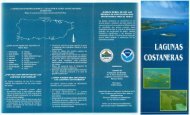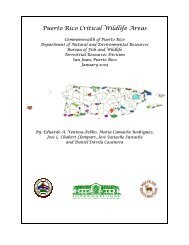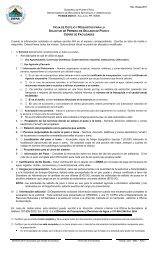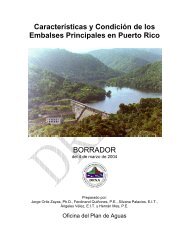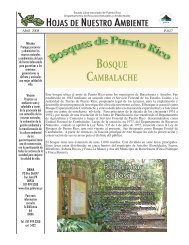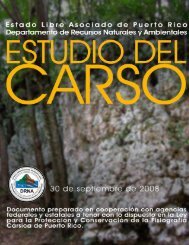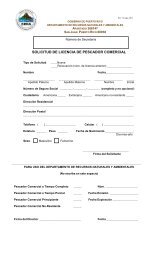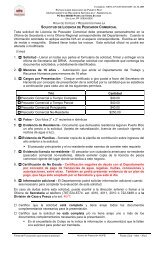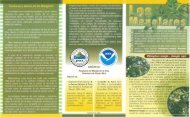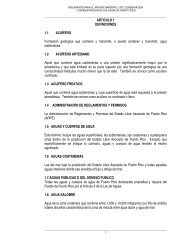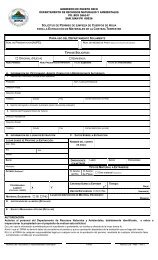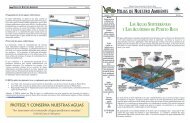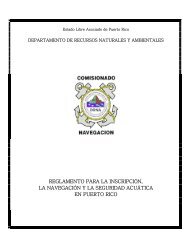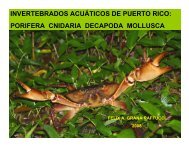determination of the spawning season of bigmouth sleeper
determination of the spawning season of bigmouth sleeper
determination of the spawning season of bigmouth sleeper
Create successful ePaper yourself
Turn your PDF publications into a flip-book with our unique Google optimized e-Paper software.
Harris et al.<br />
TABLE 1. Source and sample size <strong>of</strong> <strong>bigmouth</strong> <strong>sleeper</strong>s sampled for GSI, plasma vitellogenin and steroid<br />
hormone concentrations. No fish remained in <strong>the</strong> captive population after <strong>the</strong> July sample.<br />
Number in sample<br />
Wild Captive<br />
Month Male Female Male Female Source population(s) <strong>of</strong> wild fish<br />
March 3 7 4 3 Nueve Pasos River and Rosario River<br />
April 3 5 3 3 Cañas River<br />
May 4 7 3 3 Nueve Pasos River<br />
June 3 5 4 4 Rosario River<br />
July 3 5 4 3 Cañas River<br />
August 5 5 — — Nueve Pasos River<br />
September 5 6 — — Nueve Pasos River<br />
October 5 5 — — Nueve Pasos River<br />
Totals 31 45 18 16<br />
insert). To ensure <strong>the</strong> greatest probability that vitellogenin<br />
from <strong>bigmouth</strong> <strong>sleeper</strong>s was bound during <strong>the</strong> assay, monoclonal<br />
mouse anti—striped bass vitellogenin antibodies were<br />
diluted 1:100 with phosphate buffered saline and 10 µL <strong>of</strong><br />
<strong>the</strong> antibody solution was added to each well <strong>of</strong> <strong>the</strong> microplates<br />
coated with monoclonal mouse anti—carp vitellogenin<br />
antibody. The aqueous solution that contained <strong>the</strong> antibodies<br />
was <strong>the</strong>n evaporated under a gentle stream <strong>of</strong> nitrogen.<br />
The assay was <strong>the</strong>n run using carp and rainbow trout<br />
(V01004301—001) vitellogenin standards and pooled <strong>bigmouth</strong><br />
<strong>sleeper</strong> controls. The greatest <strong>bigmouth</strong> <strong>sleeper</strong> vitellogenin<br />
binding affinity occurred when compared to <strong>the</strong><br />
carp vitellogenin standard. Since <strong>the</strong> carp vitellogenin assay<br />
is not known to detect rainbow trout vitellogenin, does not<br />
bind striped bass vitellogenin, and <strong>the</strong>re is a high probability<br />
that a portion <strong>of</strong> <strong>the</strong> monoclonal mouse anti—striped bass<br />
vitellogenin antibodies were removed during <strong>the</strong> washing<br />
phase, only <strong>the</strong> unaltered carp vitellogenin ELISA was used<br />
for <strong>determination</strong> <strong>of</strong> vitellogenin concentrations from <strong>bigmouth</strong><br />
<strong>sleeper</strong>s during <strong>the</strong> study.<br />
Because hormone trends were <strong>of</strong> interest, and not absolute<br />
concentrations, only partial validations were conducted<br />
for <strong>the</strong> vitellogenin, estradiol, and progesterone assays to<br />
determine <strong>the</strong> suitability <strong>of</strong> <strong>the</strong> kits for detecting hormonal<br />
shifts in <strong>bigmouth</strong> <strong>sleeper</strong>s. The samples were thawed and<br />
150 µL <strong>of</strong> plasma from 3 males were pooled and used for <strong>the</strong><br />
male standard and 5 females were pooled and used for <strong>the</strong><br />
female standard to validate each kit. All samples were run in<br />
duplicate for <strong>the</strong> validation procedures and sample hormone<br />
<strong>determination</strong>. Validation tests followed <strong>the</strong> Validation <strong>of</strong><br />
Analytical Procedures: Methodology (FDA CVM 1999) and<br />
were similar to validation tests used in Barry et al. (1993) for<br />
a cortisol ELISA. Accuracy was tested by calculation <strong>of</strong> recoveries<br />
from samples spiked with known amounts <strong>of</strong> hormones<br />
(3 increments <strong>of</strong> <strong>the</strong> hormone standards provided with <strong>the</strong><br />
kits). Precision was tested by repeated assays <strong>of</strong> samples (8<br />
times in duplicate) on <strong>the</strong> same plate and by calculation <strong>of</strong><br />
44<br />
coefficient <strong>of</strong> variation (%<br />
CV). Mean sample recovery<br />
percentage limits <strong>of</strong> within<br />
90—110% were defined as<br />
meeting validation criteria.<br />
A percent coefficient <strong>of</strong><br />
variation <strong>of</strong> ≤ 20.0 was set as<br />
<strong>the</strong> acceptable limit for <strong>the</strong><br />
intra—assay % CV.<br />
Statistical analyses<br />
Plasma vitellogenin, steroid<br />
hormone concentrations,<br />
and GSI values were<br />
plotted over time to illustrate<br />
monthly trends in reproductive<br />
development,<br />
and to examine relationships<br />
between gonad maturation and hormone levels. To<br />
determine significant monthly trends, one—way analysis <strong>of</strong><br />
variance (ANOVA) was used unless data failed normality,<br />
in which case Kruskal—Wallis non—parametric test <strong>of</strong> ranks<br />
was employed. In ei<strong>the</strong>r test, month served as <strong>the</strong> main effect.<br />
The Kolmogorov—Smirnov test (with Lilliefors’ correction)<br />
was used to test data for normality. Pair—wise multiple<br />
comparisons were used to separate months. Differences in<br />
GSI, hormone and vitellogenin concentrations <strong>of</strong> wild and<br />
captive populations were analyzed using a Student’s t—test<br />
conducted by month. In cases where normality tests failed,<br />
analyses were conducted using a Mann—Whitney Rank Sum<br />
Test. These tests were chosen over paired data tests because<br />
periodicity <strong>of</strong> peaks was <strong>of</strong> interest, and may not have been<br />
discerned by a paired—t test or ANOVA on repeated measures.<br />
A Pearson product—moment correlation coefficient<br />
was used to analyze correlation <strong>of</strong> hormones and GSI for<br />
individual fish. Data for GSI were transformed by taking<br />
ArcSine <strong>of</strong> <strong>the</strong> square root as per Osborne (2002). Statistical<br />
significance for all tests was set at an alpha level <strong>of</strong> 0.05 (Zar<br />
1999).<br />
results<br />
Fish characteristics<br />
A total <strong>of</strong> 57 wild female <strong>bigmouth</strong> <strong>sleeper</strong>s and 31 wild<br />
male <strong>bigmouth</strong> <strong>sleeper</strong>s were collected for this study. Mean ±<br />
se size <strong>of</strong> wild—caught females was 226 ± 3 mm TL and 100<br />
± 4 g.; wild—caught males averaged 271 ± 10 mm TL and 185<br />
± 23 g in size. Sixteen captive females and 18 captive males<br />
were sacrificed for this research. Captive females averaged<br />
253 ± 11 mm TL and 134 ± 16 g, and captive males averaged<br />
270 ± 13 mm TL and 156 ± 22 g. The general linear model<br />
indicated that differences in fish TL occurred (Overall model:<br />
F 12, 51 = 5.71, p < 0.0001, r 2 = 0.57), with month (F 3 = 6.02,<br />
p = 0.0014, r 2 = 0.10) and sex (F 1 = 20.84, p < 0.0001, r 2 =<br />
0.34) contributing to <strong>the</strong> observed variability. Total length



